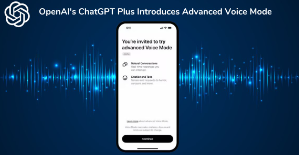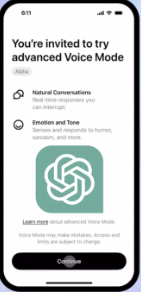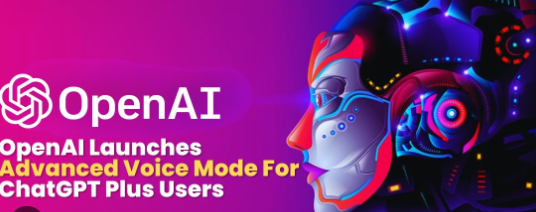Open AI has taken a bold step forward with the release of its Advanced Voice Mode for Chat GPT, offering users a more dynamic and interactive audio chat experience. Designed for those subscribed to Open AI’s premium service, this feature aims to create seamless, real-time conversations, making Chat GPT even more human-like and responsive.
Key Features:
- Natural Conversations in Real-Time: The new advanced voice mode delivers smooth and interactive dialogues, pausing and adapting to user input in real-time. Users can interrupt the chatbot, making the conversation flow more naturally.
- Customizable Voices: With nine distinct voices to choose from, users can customize their experience by adjusting the voice’s tone, speed, or even requesting specific accents, such as a Southern drawl or British English. This feature makes Chat GPT more versatile, catering to diverse linguistic needs.
- Perfect for Language Practice: The improved foreign language accent recognition makes Chat GPT a valuable tool for language learners. Users can practice speaking and listening, enhancing their skills with feedback from an AI that adapts to different accents.
- Multiple Use Cases: From telling bedtime stories to preparing for job interviews, the voice mode offers a wide range of applications. It can be used as a virtual assistant, a learning tool, or even a casual conversationalist.
How to Access Advanced Voice Mode:
To access this cutting-edge feature:
- Subscribe to Chat GPT Plus, Team, or Enterprise plans, starting at $20 per month.
- Ensure your device has the latest version of the Chat GPT app.
- Once updated, a soundwave icon will appear next to the microphone in the app, allowing users to initiate audio chats.
Exclusive to Premium Subscribers
Open AI’s Advanced Voice Mode is available exclusively to premium users, enhancing the value of the paid subscription. As the feature rolls out, it will initially be available in select regions, excluding the EU, UK, Norway, and others. Users will receive an in-app notification once the feature is live for their account.
Competing with Industry Giants
As Open AI pushes the boundaries of AI voice capabilities, it faces growing competition from tech giants like Google and Meta. Google recently introduced the Gemini Live voice feature on Android, while Meta is set to release celebrity voices across Facebook, Instagram, and WhatsApp. Despite the competitive landscape, Open AI’s head start in the generative AI chatbot market, with over 200 million weekly active users, gives it a strong foothold.
Limitations
While the advanced voice mode offers a high-quality experience, users may encounter usage limits. Some have reported time restrictions after about 30 minutes of continuous use, though Open AI has yet to provide detailed guidelines on these limits.
The Future of AI Conversations
Open AI’s voice feature marks a significant leap in the evolution of AI communication, making interactions with Chat GPT more natural and efficient. As Open AI continues to innovate, this advanced voice mode sets the stage for even more immersive and customizable AI experiences, positioning it at the forefront of the rapidly growing AI market.
Tags: Open AI, Chat GPT voice mode, AI conversations, advanced AI features, generative AI, Chat GPT subscriptions, AI technology trends, language learning, AI innovation

Overview of Advanced Voice Mode
- Purpose and Goals:
- The Advanced Voice Mode aims to enhance user interaction by making conversations with Chat GPT more fluid and lifelike. By incorporating voice features, Open AI seeks to mimic the nuances of human dialogue, which can improve user engagement and satisfaction.
- Technical Implementation:
- The voice mode likely utilizes advanced speech synthesis technology, which includes deep learning algorithms that generate human-like voice outputs. This involves a combination of text-to-speech (TTS) systems that can understand and generate speech in various tones and accents.

Key Features Expanded
- Real-Time Interaction:
- The ability to interrupt and engage in a back-and-forth conversation without awkward pauses can significantly enhance the user experience. This feature might involve complex natural language processing (NLP) techniques that allow the AI to process input and generate responses on the fly.
- Voice Customization:
- The nine distinct voices available for selection could cater to various user preferences, enhancing personalization. Users may appreciate being able to choose a voice that feels more comfortable or relatable to them, potentially increasing their affinity for the tool.
- Language Learning Utility:
- The emphasis on language practice is particularly relevant given the increasing demand for language learning tools. This could position Chat GPT as a companion for language learners, offering a risk-free environment to practice speaking and listening skills.
User Access and Subscription Models
- Premium Subscription Benefits:
- The exclusive availability of the voice feature to premium subscribers reinforces the value of the Chat GPT Plus, Team, or Enterprise plans. This model encourages users to upgrade, potentially boosting Open AI’s revenue while providing enhanced features to paying customers.
- In-App Notifications:
- The rollout strategy, which includes in-app notifications for availability, is a smart move to keep users informed and engaged, ensuring that they are aware of new features as they become accessible.
Competitive Landscape
- Comparison with Competitors:
- Open AI’s early entry into the generative AI space has given it a competitive edge. However, competitors like Google and Meta are rapidly evolving their offerings. The introduction of features like Google’s Gemini Live voice highlights the urgency for Open AI to continually innovate to retain its lead.
- Market Position:
- With a substantial user base, Open AI can leverage its position to experiment with new features and gather user feedback, further refining the product based on real-world use cases.

Limitations and Future Considerations
- Usage Limits:
- The reported time restrictions could indicate server load management or a strategy to ensure quality interactions without overwhelming the system. Clear communication about these limits will be crucial to maintaining user trust.
- Future Enhancements:
- Looking ahead, Open AI could explore incorporating more features like contextual awareness (remembering previous interactions) or multi-language support in real-time conversations. This would broaden the applicability of Chat GPT in diverse user scenarios.
Open AI’s Advanced Voice Mode represents a significant step in the evolution of conversational AI, combining technological sophistication with user-centric design. As the landscape of AI communication continues to evolve, the success of this feature will depend not only on its functionality but also on how well it adapts to user needs and competitive pressures.

